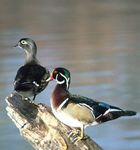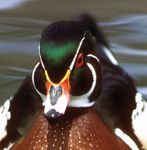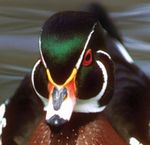Kentucky Wood Ducks - Kentucky Department of Fish and Wildlife Resources
←
→
Page content transcription
If your browser does not render page correctly, please read the page content below
Dr. Jonathan Gassett, Commissioner
Kentucky Department of Fish & Wildlife Resources
#1 Sportsman’s Lane, Frankfort, KY 40601
1-800-858-1549 • fw.ky.gov
Kentucky
Wood Ducks
Written by Russ Kennedy
Edited by Ronald D. Pritchert
Illustrations and design by Adrienne Yancy
December 2008
Material for this booklet was compiled from U.S. Geological Survey
and U.S. Fish & Wildlife Service publications as well as from the
Kentucky Breeding Bird Atlas (Palmer-Ball Jr., 1996).
Cover photo courtesy of the U.S. Fish & Wildlife Service.The Kentucky Department of Fish and Wildlife Resources (KDFWR)
annually conducts more than two dozen intensive wood duck brood
surveys statewide. And while woodies are recorded on nearly every stream
throughout the Commonwealth, they are most abundant in the floodplain
sloughs, swamps and wooded wetlands of western Kentucky.
The modern-day construction of large reservoirs and farm ponds
has, in many instances, created suitable wood duck habitat and bolstered
populations in many areas including central and eastern Kentucky. An
aggressive program to provide artificial (wooden) nest boxes also has had
a positive population effect.
U.S. Fish & Wildlife Service photo
Habitat
Wood ducks thrive in woodland areas along streams, rivers, lakes
Kentucky Wood Ducks and vegetated freshwater wetland areas. Bottomland hardwood wetlands,
Many regard the wood duck (Aix sponsa) as North America’s most beaver ponds, oxbows, meanders and backwaters are preferred habitat
beautiful waterfowl species. Distinguished by their colorful plumage – the types. Preservation and management of old growth timber along river
scientific name means “waterbird in bridal dress” – woodies, as they are corridors produces especially high-quality wood duck habitat.
commonly called, are medium-sized ducks, usually weighing around 1 ½ Woodies feed primarily in shallow-water areas on aquatic plants and
pounds. A typical adult wood duck is 17-20 inches long and has a 30-inch
wingspan. Their broad, relatively short wings aid acrobatic flight through Figure 1. Distribution and breeding range of the wood duck. Map based on Cornell
thick woods and other tight cover. Lab of Ornithology data.
Actually, it’s the male wood duck that sports the vivid maroon, white,
blue, green, red and black plumage. The female’s grayish-brown coloration
might be considered quite bland in comparison to her male counterpart.
Her ‘earthtones’ provide an important ground camouflage function during
the brood-rearing period.
John James Audubon (1861) labeled wood ducks “abundant” in western
Kentucky in the early 1800’s. However, widespread clearing and draining
of their wooded wetland habitat in the Mississippi River floodplain led to
sharp population declines.
At one time plentiful throughout their natural range (Fig. 1), wood
duck numbers plummeted to alarming lows in the mid-late 19th century.
By the early 1900’s, wood ducks had all but disappeared from North
America, the victims of habitat destruction and unregulated hunting.
Today, thanks to scientific wildlife management and modern
conservation practices, wood ducks are abundant across their natural
range. Hunting is again permitted in Kentucky and throughout North
America. Wood ducks are important to Kentucky waterfowlers and in
many years is the second most common duck harvested.
2 3seeds, insects and invertebrates. They also forage on the forest floor for
acorns, nuts and seeds. Aquatic insects and invertebrates are particularly
important for adult hens during spring nesting activities. Acorns, hickory
nuts and other forest mast are most important as fall and winter foods, as
are the seeds of cypress, sweet gum and buttonbush.
Habitat components must be available in relative close proximity to one
another for wood duck reproduction and survival to occur. The highest-
quality nesting habitat is of little consequence if the nearest brood-rearing
habitat is more than a mile away. Similarly, good brood-rearing habitat is
useless in the absence of nearby nesting habitat.
Prime wood duck habitat is also attractive to other waterfowl species
including mallards, black ducks, hooded mergansers and ring-necked ducks.
Migration
Wood ducks are a ‘migratory’ species. While a few stay in Kentucky
throughout the year, most move south (i.e. migrate) toward the Gulf of
Mexico when cooler fall weather invades the Commonwealth.
Wood ducks migrate in pairs or small flocks and return in late February
to mid-March to begin springtime nesting activities.
Interestingly enough, Kentucky’s fall and winter wood ducks (those we
encounter during the traditional hunting seasons) are usually visitors from
other states to the north. When colder temperatures signal Kentucky’s
resident woodies that it’s time to journey south, the arrival of brisk winds,
colder temperatures and snow in the more northern states sends a similar
“time-to-head-for-warmer-climes” message to migratory waterfowl in
higher latitudes.
When winter begins to fade and spring arrives, “resident” woodies
that have wintered to the south return home to Kentucky, while birds that
have wintered here return to their more northern ranges.
Reproduction
Wood ducks nest in natural tree cavities and in some cases, openings
created and abandoned by woodpeckers. In the absence of natural cavities,
man-made nesting boxes are readily accepted, when built to prescribed
dimensions. (Wood duck nest boxes are discussed in detail elsewhere in
this booklet.)
The average clutch size for wood ducks is 10-15 dull white eggs,
however nests have been found to contain 30 or more. The hen usually Photo © Maslowski Wildlife Productions
lays one egg daily until her job has been completed. Wood duck hens will readily accept man-made nest boxes.
4 5The month-long incubation period begins after the last egg is laid. duck habitat and should be left undisturbed whenever possible.
While broods of young birds usually start appearing around the first of As with many wildlife species, the greatest threat to wood ducks is the
May through early June, the peak of the hatch occurs from mid-May to continued loss of habitat. By protecting and restoring floodplain timber,
mid-June. In some years the hatch extends through early July. river oxbows and meanders, and other freshwater and riparian habitats, we
Hatchlings usually leave their nest after just 24 hours. The mother hen can help insure the future for wood ducks.
stays with her brood until they can fly, typically 8-10 weeks. Guided by the principles of scientific wildlife management, reservoir
‘Egg dumping’ (i.e., intraspecific brood parasitism) occurs when a and pond construction, wetland habitat reclamation and development, and
female wood duck, usually a first-year breeder, follows another hen to conservative harvest limits have contributed greatly to the wood duck’s
her nest site and subsequently utilizes it. Dumping most often happens population resurgence.
when suitable nesting sites are in short supply or when nest boxes are
clumped together. Private Land Management
Except in egg-dumping situations, approximately 80 percent of Man-made shallow-water impoundments can provide excellent habitat
wood duck eggs will hatch. Hatch rates can drop as low as 10 percent in for wood ducks and other migratory waterfowl. These impoundments
a dump nest. catch and hold rain and runoff behind levees (earthen dams).
Unfortunately, low survival rates are common among waterfowl It is important to distinguish between duck-friendly, shallow-
species. Up to 90 percent of newly hatched wood ducklings will die in their water impoundments and farm or fish ponds. A farm/fish pond doesn’t
first two weeks – only a 10 percent survival rate. As the wood duck’s 90 necessarily provide favorable duck habitat.
percent early mortality rate is higher than for many prairie ducks, nature Typical farm pond features include an average depth of three or
compensates for that disparity with increased clutch size and a vigorous more feet, steeply sloping sides, brush-free banks, and smooth, bulldozed
re-nesting drive. The survival rate improves to 50 percent among birds bottoms. Ponds built for ducks are not more than a couple of feet deep at
that survive those first 14-15 days. most (an average depth of 12-18 inches is ideal!) and offer gently sloping
banks so ducks can easily walk up on shore.
Management A duck pond might also provide a couple of small islands for ground-
Wood ducks respond well to habitat protection and enhancement, nesting waterfowl. As noted, woodies are cavity nesters, but other desirable
meaning that landowners and habitat managers can assist in the continued waterfowl like mallards and Canada geese will also be attracted to the
success of wood ducks and other migratory waterfowl species that rely on duck pond and will nest on the islands.
similar aquatic habitat. It is possible, given proper slope, to build a farm/fish pond that also
Often considered nuisances, beaver ponds can provide excellent wood provides suitable duck habitat (Fig. 2). The slope must be such that deeper
water can collect at the levee end while only very shallow water (12-18
Figure 2. Duck-friendly farm pond.
6 73:1 slopes
Water flow
FLASHBOARD RISER
Removable 2” x 8”
stoplogs for regulating
water level
Discharge pipe
Riser cover
Proposed water level
FULL-ROUND RISER
Water flow
Inlet pipe with beaver guard Discharge pipe with beaver guard
Figure 3. Sample water control structures. For more information on these and other
inch depths) collects at the opposite end. such structures see www.southern.ducks.org/WaterControlStructures.php.
A convenient drainage system will allow for late spring draining so
marshy vegetation that will provide next year’s food and cover can sprout Unlimited, Inc., the U.S.
and take hold on the pond’s bottom and banks during the growing season. FLASHBOARD Fish & Wildlife Service
Seeds from annual plants that thrive in wet areas remain viable for years RISER DETAIL and the U.S. Department of
and will germinate in moist, exposed soil. Agriculture (USDA)’s Natural
A water-control structure (WCS) installed in the levee (Fig. 3) during ¾” hot-rolled round Resources Conservation
construction will provide a landowner or habitat manager the ability to bar welded to riser Service (NRCS), provides free
manipulate the water level in a shallow-water impoundment, often called water-control structures for
a moist-soil unit (MSU). In late fall, the WCS can be closed to trap and (2 each) 3/16” x 2 ½” approved habitat-development
hold rain and runoff. The structure allows for the gradual build-up of strips, welded to form projects. Read more about
water so as the moist-soil vegetation that has come in over the summer 2” wide channel KPWW elsewhere in this
growing season is “used up” (consumed), the water’s surface area can be publication, or go online:
expanded to cover unused aquatic plants along new edges. Center saddle-cut fw.ky.gov. From the home
A landowner-assistance program called Kentucky Partners for 2” above bottom page, click on Wildlife, then
Wetland Wildlife (KPWW), offered jointly by KDFWR, Ducks on Programs.
8 9Figure 4.
Nest Boxes for Wood Ducks
Lag bolt Building and installing nest boxes can provide much fun and enjoyment
IDEAL
for the landowner and serves an important function for wood ducks.
WOOD DUCK Nest boxes should be constructed of a weather-resistant wood;
¼˝ mesh NEST BOX cypress is an excellent choice and oak works well. Never use treated
hardware lumber! (Treatment chemicals kill embryos.) Paint or stain is okay as it
cloth
Spacing blocks
aids in weather protection, but should be applied only on the outside.
(3˝ wide) Nest box dimensions can vary and numerous designs have proven to
tacked to
work well. Hole size is more important – an oval 3 inches high and 4
inside
inches wide is preferred.
Wood The KDFWR recommends the traditional larger-size nest boxes that
chips are 24 inches tall (Fig. 4) with inside dimensions of 10x10 or 10x12 inches.
Smaller-size boxes typically 8 inches wide, 15 inches tall and 12 inches
deep have been used in recent years with some success.
12˝ Whether building a box of traditional or smaller dimensions, cut the
SIDE VIEW backing board an inch or two longer than the main body of the box and
FRONT VIEW
drill center holes at both ends for easy wood-screw or lag-bolt installation.
16˝ Also allow for an inch or so of overhang on the front and sides when
cutting the top.
Install a three-inch wide Drill small
2˝ 10˝ Floor drain holes
piece of ¼-inch hardware cloth
Pivot (wire mesh) on the inside, under in the floor
Predator Guard
3˝
4˝ x 4˝ cedar post (2˝ metal pole may also be used)
nails
the entrance hole. The mesh works 22¾˝ Side 24˝
4˝ like a ladder to assist ducklings in
22¾˝ their climb to the entrance/exit
hole. Be sure to fold back cut edges
to avoid injury to the hen and newly 24˝ Side 22¾˝
hatched birds.
A few ¼-inch holes drilled
Latch 1 inch
in the bottom of the box should
nail rough lumber
14˝ provide adequate drainage. 24˝ Back
A three-inch layer of wood Roof 14˝
chips (available at your local pet
store) makes excellent nesting 16˝
material. Avoid straw or hay as 22¾˝ Front
they may be contaminated. Sawdust NEST BOX
doesn’t drain nearly as well as chips, DIMENSIONS
12˝
and should be only a second choice.
10 11Install the top, one side or the front so that it can be opened for
cleaning and/or monitoring.
Annual cleaning is a key element in maintaining a successful nest
box and provides an opportunity to monitor usage. Replace the nesting
material in the bottom of the box annually. This annual refurbishment
is best performed in mid-late winter, well ahead of nesting (and nest site
selection) season. A pre-February service date will assure that new nesting
material remains relatively fresh and lessens the likelihood of scaring off
interested wood ducks.
Nesting woodies don’t bring anything to the box, so if you find other
nesting materials (straw, twigs, etc.) present, a starling or some other
‘competing’ winged user brought them there. In the case of a dump nest,
you might find abandoned, unhatched eggs. Finding shell fragments and
membrane is a good indicator of a successful nest. Shell fragments without
membrane can be the residual of an untimely predator visit.
It can take a while for woodies to adjust to the presence of nest boxes,
so don’t be disappointed if a newly installed unit is not used in the first
available season. As a matter of fact, it can sometimes take several years for
wood ducks to move in. Remember, these man-made nesting structures
are a ‘second choice’ and will be used only when they provide the best or
easiest nesting option.
Nest Box Placement
Proper placement is as important as proper construction – wood
ducks like their nesting privacy. Nest boxes should be placed at least 100
yards apart and should not be visible to one another, to minimize nest
dumping. Clumping or bunching of boxes is counter-productive and not
recommended. Apply the “less is more” theory.
Birds hatched in nest boxes tend to choose nest boxes over natural
cavities in trees when it comes time for their own nesting activities.
Conversely, birds hatched in natural cavities will first search for same when
they choose a nest site. Because of this ‘imprinting’ behavior, a successful
nest box program will ‘grow’ a breeding flock as woodies return each year
and boxes can then be added gradually over a period of time.
Nest boxes can be placed on land or over water. Ideally, your box
will be in or over water and in a fairly well ‘covered’ area. Avoid sites
in an open space. Away from water, secluded areas within timber stands
offer preferred sites, but make sure the nest box faces and that there’s a
Photo © Maslowski Wildlife Productions
reasonably clear path to the water.
12 13Mount your nest box on
a pressure-treated 4x4-inch
post, a galvanized steel fence
Nest box
post or PVC pipe. In most
cases, it is highly advisable
3 mounting to steer clear of installation
2" PVC
blocks directly on trees to avoid
pipe
tree damage and reduce
predation. A galvanized sheet
metal predator guard (Fig. 5)
is highly recommended and
will protect the hen and her
ducklings from raccoons,
snakes and other predators.
By its very composition, PVC
36" above
pipe is too slick for predators
ground,
minimum to climb.
When setting posts, be
Galvanized sure that one-third is actually
steel fence
in the ground. For example,
post
a 10-ft. long 4x4-in. post
should be set 3-3½ ft deep
into the ground leaving 6½-7
ft. exposed. Ideally, your nest
box entrance/exit hole will be
facing the water 5–6 ft. above U.S. Fish & Wildlife Service photo
the ground or water surface.
The KPWW program
Wood Ducks - A Genuine Treasure
Figure 5. Predator guard.
provides wood duck nesting The story of the wood duck is a grand example of how active and
boxes, 4x4 posts and predator guards free of charge for approved projects. aggressive wildlife management techniques and modern conservation
A site visit by your KDFWR private land biologist (PLB) or NRCS practices can have a positive effect on the overall success of a particular
Liaison is required and will help determine suitable spots for nest box species.
placement as well as an appropriate number. While wood duck populations have recovered dramatically, the greatest
To learn more about KPWW, wood duck nest box boxes, or any other threat to their future, as with many wildlife species, is continued habitat
wildlife habitat program, speak to your nearest PLB or NRCS Liaison. destruction. By protecting and restoring freshwater wetland habitats,
Contact information is listed on KDFWR’s web site: fw.ky.gov. From the wildlife managers and private landowners can jointly assure the continued
home page, click on Wildlife, then on Contacts. success of wood ducks and other migratory waterfowl species.
If you’re still not sure who your PLB is, give us a call. Contact the
KDFWR; phone 1-800-858-1549.
14 15This publication was partially funded with Federal Aid Pittman Robertson Funds (PR).
The Kentucky Department of Fish and Wildlife Resources is funded through the sale of
hunting and fishing licenses. It receives no general fund tax dollars.You can also read
























































